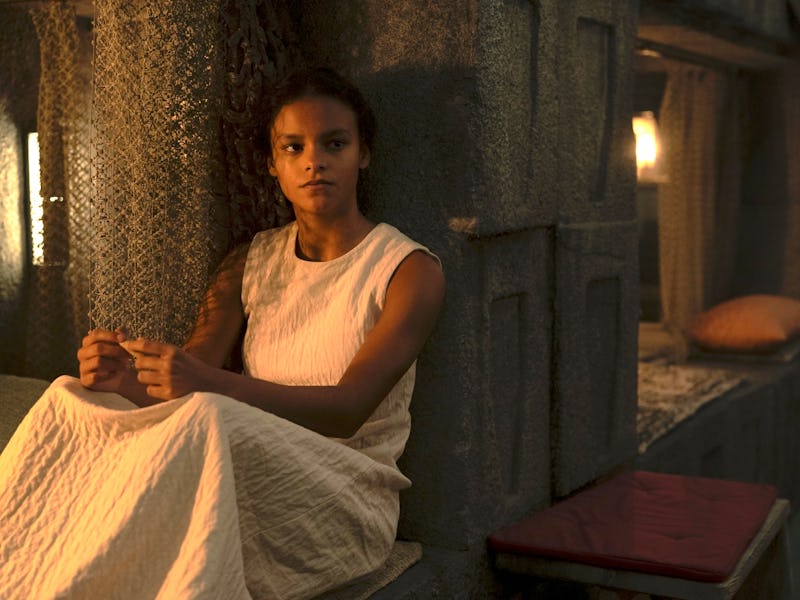What is “The Agony?” How Dune's Deep-Cut Superpower Can Unlock Its Greatest Mystery
Forget seeing the future — what if you could experience the entire past?

One of the most powerful ideas in Dune is the slippery concept of memory. While the original novel is famous for Paul’s ability to remember the future through prescience, the book also contains an equally cool concept: the ability of a Reverend Mother — either of the Fremen or the Bene Gesserit — to gain the memories of the Reverend Mothers before them. On top of that, it was also possible, occasionally, for certain people to not just gain the memories of previous Reverend Mothers, but all of their own ancestors.
In the second episode of Dune: Prophecy, Sister Lila (Chloe Lea) chooses to undergo a process called “The Agony,” which is, essentially, a very similar process to the first novel called “The Spice Agony.” But why is Lila doing this again? And who is that person that she meets in her memory?
Spoilers ahead for Dune: Prophecy, Episode 2, “Two Wolves.”
Fighting the Burning Truth
Sister Tula (Olivia Williams) worries about hidden information from the past.
After Mother Valya (Emily Watson) learns that young Pruwet Richese (Charlie Hodson-Prior) and Sister Kasha (Jihae) were both murdered by an inexplicable burning of their flesh, she heads to the home world of the Imperium, Selesca Secundus to figure out what’s going on. But, in the meantime, she’s leaving Tula (Olivia Williams) in charge of the Sisterhood, and that means, she wants Tula to do some investigating, too.
But, she’s not asking Tula to dig through old archives. Valya is sure that these fatalities are linked to the Prophecy of the “Burning Truth,” in which the Sisterhood will be judged by a holy tyrant. Valya isn’t going to go down without a fight, but she needs information from the distant past. “We must understand how this prophecy will unfold,” she tells Tula. “We’ve never seen a force like this. We don’t know how to fight it.”
The idea here is this: the only way to crack the details of the Prophecy and fight the Burning Truth is to access the memories of people who were actually around when the Prophecy was written. Vayla tells Tula that young sister Lila needs to “connect with her ancestors.” And this begins the deep-cut process that comes from the first novel, but also informs much of what happens in Children of Dune, too.
What is “The Agony” in Dune?
The Water of Life ceremony in the 1984 Dune.
The way “the Agony” works in both classic Dune and Prophecy is through the ingestion of poison. In the first Dune, it’s called “The Spice Agony,” and it happens when Jessica is forced to drink “The Water of Life” which is basically sandworm bile. The ability of a member of the Sisterhood to be able to alter the poison within her body is one of the hallmarks of the Bene Gesserit, and, generally speaking, only women are capable of this feat, not men. Here, a blue substance is prepared from “Rossak poison,” which is a term that comes from the expanded universe Dune books, upon which Prophecy is based. (Though this specific term comes from The Battle of Corin, which predates Prophecy by about half a century.)
In any case, the process that Jessica and Paul went through in Dune: Part Two, in which they could see all their ancestors (and Paul learned he was related to Baron Harkonnen) has basically the same impact in Dune: Prophecy even if the poison used is a bit different. In fact, this difference is baked into the original lore. In the original Dune, as Jessica realizes what is happening to her with the Water of Life poison, she thinks: “[It] had transformed her. This wasn’t exactly how they did it at the Bene Gesserit school, she knew. No one had ever introduced her to the mysteries of it, but she knew. The end result was the same.”
The end result is clear: You can commune and gain direct understanding with your ancestors. But there’s a big danger!
Why “The Agony” Creates a Big Twist
Camilla Beeput as Sister Dorotea — her memory lives on, literally!
Before Lila takes the poison, and thus, gets to the point where she can communicate with her ancestors, Tula points out that this is perhaps not a great idea. “It endangers not just her life,” she says. “There are secrets we have gone great lengths to keep.”
And at the end of the episode, it becomes clear what those secrets are: Lila is the biological daughter of the deceased Dorotea (Camilla Beeput), the person whom Valya murdered in the first episode by using the Voice to make Dorotea stab herself. So not only is Lila being confronted with this fact in her own mindscape, but at the same time, it appears that she might be fully taken over by these ancestral memories.
This connects to the third Dune book, Children of Dune, in which Alia, Paul’s sister, is semi-possessed by the memory spirit of Baron Harkonnen, making a kind of Jekyll and Hyde situation inside of Alia’s mind. In the time frame of Dune and Children of Dune, the Bene Gesserit refer to this state as “abomination,” but here, the Sisterhood hasn’t quite arrived at that belief. And perhaps the tragic events that are happening not just to Lila — but the undead memory spirit of her mother — are exactly why, 10,000 years later, the Sisterhood is a little more careful with letting the memories of the past fully take hold of the present.